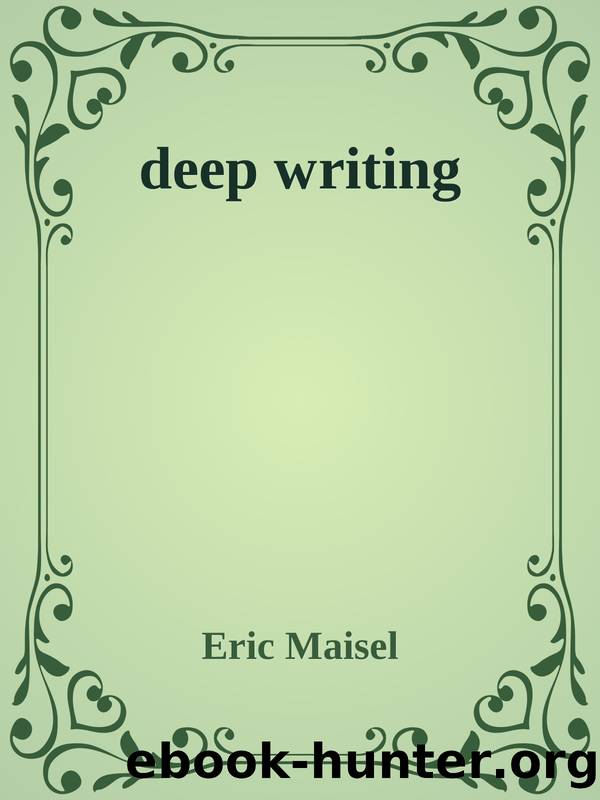deep writing by Eric Maisel

Author:Eric Maisel [Maisel, Eric]
Language: eng
Format: epub
Publisher: Jeremy P. Tarcher/Putnam, Penguin Putnam Inc.
Published: 2014-01-03T20:50:39+00:00
Our Writers Begin to Choose
At the point where we left them, our five writers had each formed a writing intention, mapped out a beginning plan, and begun to think about their projects. Amelia was thinking about a novel set in an insane asylum. Marjorie started on a mystery at whose heart was her own anger with her mother. Sam set out to do research on the subject of the emotional support of employees. Anne decided to do character sketches of unfamiliar women and to check out the requirements of bestseller fiction. Henry toyed with the idea of investigating his own bisexuality.
Had they factored the marketplace into their calculations yet? No; only Anne has consciously wrestled with the issue at all. Will they begin to factor in marketplace considerations as they make their next writing choices? Probably not, since thinking about the marketplace is not uppermost in a writer’s mind as she begins to wrestle with her material. We might hope and wish that our writers invent an exercise equivalent to the framing exercise presented in this chapter or in some other way think about angling their work toward potential readers. But this is rarely how a writer begins, consumed, as she usually is, with how to most effectively bring her thoughts and feelings to life.
Amelia’s working title for her insane asylum book is the Jane Austen—like Pain and Possibility. Her way of working is to write whatever comes to mind, to write without censoring herself. This way of writing feels chaotic, wild, and even dangerous, but is also the most natural. When she reads the scene fragments she’s producing—here a scene that is nothing but the description of a scream, there a scene that is nothing but a snapshot of the yellow walls of the asylum—she worries that she’s producing a gigantic pile of puzzle pieces that she won’t be able to fit together. But she shrugs that possibility away and continues to write on the wild side.
Marjorie’s working title is The Old Lady Dies. She finds herself writing scene after scene between a mother and daughter, even though these scenes keep putting the murder off. She has the suspicion that she should step back and make an outline, plot the novel, refine her detective’s character, spend time working on the setting —make some efforts at order. But for now she feels compelled to write intense, almost unbearably sad mother-and-daughter scenes, simultaneously letting neither character off the hook while preparing for the murder. Her choice, like Amelia’s, is to go where she feels she must go—to just write.
Sam has made a different sort of choice. Out of fear that he has nothing to say and a belief that he’d better toe the line, he retreats from his commitment to examine his subject. He makes the decision to choose a simpler subject, one recommended by his thesis adviser. Sam commences a literature search and soon accumulates hundreds of synopses and citations. But he can feel his writer’s block returning with a vengeance.
Download
This site does not store any files on its server. We only index and link to content provided by other sites. Please contact the content providers to delete copyright contents if any and email us, we'll remove relevant links or contents immediately.
Big Magic: Creative Living Beyond Fear by Elizabeth Gilbert(5667)
Paper Towns by Green John(5121)
On Writing A Memoir of the Craft by Stephen King(4886)
The Doodle Revolution by Sunni Brown(4707)
Hyperfocus by Chris Bailey(4078)
Evolve Your Brain by Joe Dispenza(3628)
Unlabel: Selling You Without Selling Out by Marc Ecko(3616)
The Red Files by Lee Winter(3387)
Draw Your Day by Samantha Dion Baker(3311)
The Power of Mindful Learning by Ellen J. Langer(3198)
The Art of Dramatic Writing: Its Basis in the Creative Interpretation of Human Motives by Egri Lajos(3029)
The War Of Art by Steven Pressfield(2905)
Applied Empathy by Michael Ventura(2860)
The 46 Rules of Genius: An Innovator's Guide to Creativity (Voices That Matter) by Marty Neumeier(2814)
How to be More Interesting by Edward De Bono(2760)
Keep Going by Austin Kleon(2721)
Why I Am Not a Feminist by Jessa Crispin(2714)
How to Stop Worrying and Start Living by Dale Carnegie(2678)
You Are Not So Smart by David McRaney(2618)
